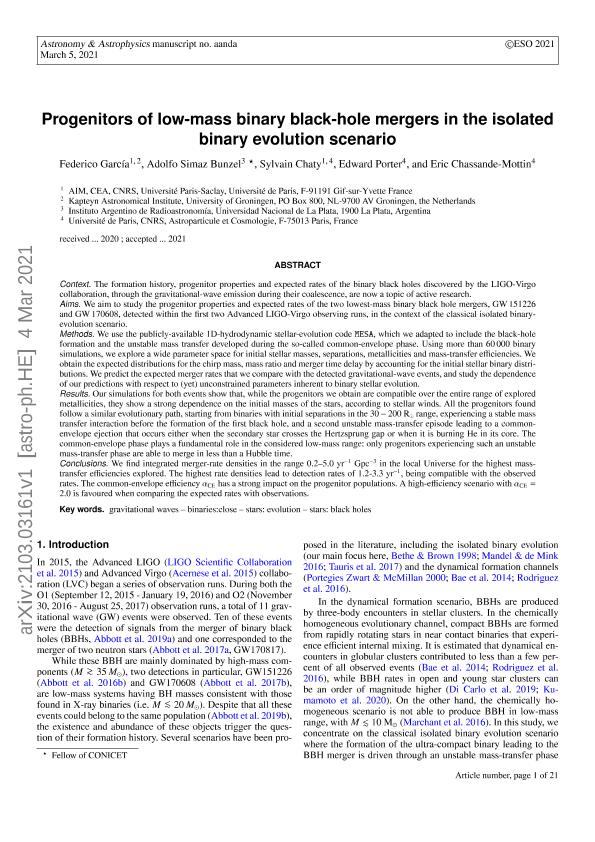Mostrar el registro sencillo del ítem
dc.contributor.author
García, Federico

dc.contributor.author
Simaz Bunzel, Adolfo

dc.contributor.author
Chaty, Sylvain
dc.contributor.author
Porter, Edward
dc.contributor.author
Chassande Mottin, Eric
dc.date.available
2021-11-04T16:57:23Z
dc.date.issued
2021-05
dc.identifier.citation
García, Federico; Simaz Bunzel, Adolfo; Chaty, Sylvain; Porter, Edward; Chassande Mottin, Eric; Progenitors of low-mass binary black-hole mergers in the isolated binary evolution scenario; EDP Sciences; Astronomy and Astrophysics; 649; A114; 5-2021; 1-21
dc.identifier.issn
0004-6361
dc.identifier.uri
http://hdl.handle.net/11336/146039
dc.description.abstract
Context. The formation history, progenitor properties, and expected rates of the binary black holes discovered by the LIGO-Virgo collaboration via the gravitational-wave emission during their coalescence are a topic of active research. Aims. We aim to study the progenitor properties and expected rates of the two lowest-mass binary black hole mergers, GW151226 and GW170608, detected within the first two Advanced LIGO-Virgo observing runs, in the context of the classical isolated binary-evolution scenario. Methods. We used the publicly available 1D-hydrodynamic stellar-evolution code MESA, which we adapted to include the black-hole formation and the unstable mass transfer developed during the so-called common-envelope phase. Using more than 60? 000 binary simulations, we explored a wide parameter space for initial stellar masses, separations, metallicities, and mass-transfer efficiencies. We obtained the expected distributions for the chirp mass, mass ratio, and merger time delay by accounting for the initial stellar binary distributions. We predicted the expected merger rates and compared them with those of the detected gravitational-wave events. We studied the dependence of our predictions with respect to the (as yet) unconstrained parameters inherent to binary stellar evolution. Results. Our simulations for both events show that while the progenitors we obtained are compatible over the entire range of explored metallicities, they show a strong dependence on the initial masses of the stars, according to stellar winds. All the progenitors we found follow a similar evolutionary path, starting from binaries with initial separations in the 30-200? R? range experiencing a stable mass transfer interaction before the formation of the first black hole, followed by a second unstable mass-transfer episode leading to a common-envelope ejection that occurs either when the secondary star crosses the Hertzsprung gap or when it is burning He in its core. The common-envelope phase plays a fundamental role in the considered low-mass range: only progenitors experiencing such an unstable mass-transfer phase are able to merge in less than a Hubble time. Conclusions. We find integrated merger-rate densities in the range 0.2-5.0 yr-1 Gpc-3 in the Local Universe for the highest mass-transfer efficiencies explored here. The highest rate densities lead to detection rates of 1.2-3.3 yr-1, which are compatible with the observed rates. The common-envelope efficiency αCE has a strong impact on the progenitor populations. A high-efficiency scenario with αCE? =? 2.0 is favoured when comparing the expected rates with the observations.
dc.format
application/pdf
dc.language.iso
eng
dc.publisher
EDP Sciences

dc.rights
info:eu-repo/semantics/openAccess
dc.rights.uri
https://creativecommons.org/licenses/by-nc-sa/2.5/ar/
dc.subject
BINARIES: GENERAL
dc.subject
GRAVITATIONAL WAVES
dc.subject
STARS: BLACK HOLES
dc.subject
STARS: EVOLUTION
dc.subject.classification
Astronomía

dc.subject.classification
Ciencias Físicas

dc.subject.classification
CIENCIAS NATURALES Y EXACTAS

dc.title
Progenitors of low-mass binary black-hole mergers in the isolated binary evolution scenario
dc.type
info:eu-repo/semantics/article
dc.type
info:ar-repo/semantics/artículo
dc.type
info:eu-repo/semantics/publishedVersion
dc.date.updated
2021-11-04T13:18:10Z
dc.journal.volume
649
dc.journal.number
A114
dc.journal.pagination
1-21
dc.journal.pais
Francia

dc.description.fil
Fil: García, Federico. Universite Paris-saclay; Francia. University Of Groningen. Kapteyn Astronomical Institute; Países Bajos
dc.description.fil
Fil: Simaz Bunzel, Adolfo. Universidad Nacional de La Plata; Argentina. Provincia de Buenos Aires. Gobernación. Comisión de Investigaciones Científicas. Instituto Argentino de Radioastronomía. Consejo Nacional de Investigaciones Científicas y Técnicas. Centro Científico Tecnológico Conicet - La Plata. Instituto Argentino de Radioastronomía; Argentina
dc.description.fil
Fil: Chaty, Sylvain. Universite Paris-saclay; Francia
dc.description.fil
Fil: Porter, Edward. Université de Paris; Francia
dc.description.fil
Fil: Chassande Mottin, Eric. Université de Paris; Francia
dc.journal.title
Astronomy and Astrophysics

dc.relation.alternativeid
info:eu-repo/semantics/altIdentifier/doi/http://dx.doi.org/10.1051/0004-6361/202038357
dc.relation.alternativeid
info:eu-repo/semantics/altIdentifier/url/https://www.aanda.org/articles/aa/abs/2021/05/aa38357-20/aa38357-20.html
Archivos asociados
